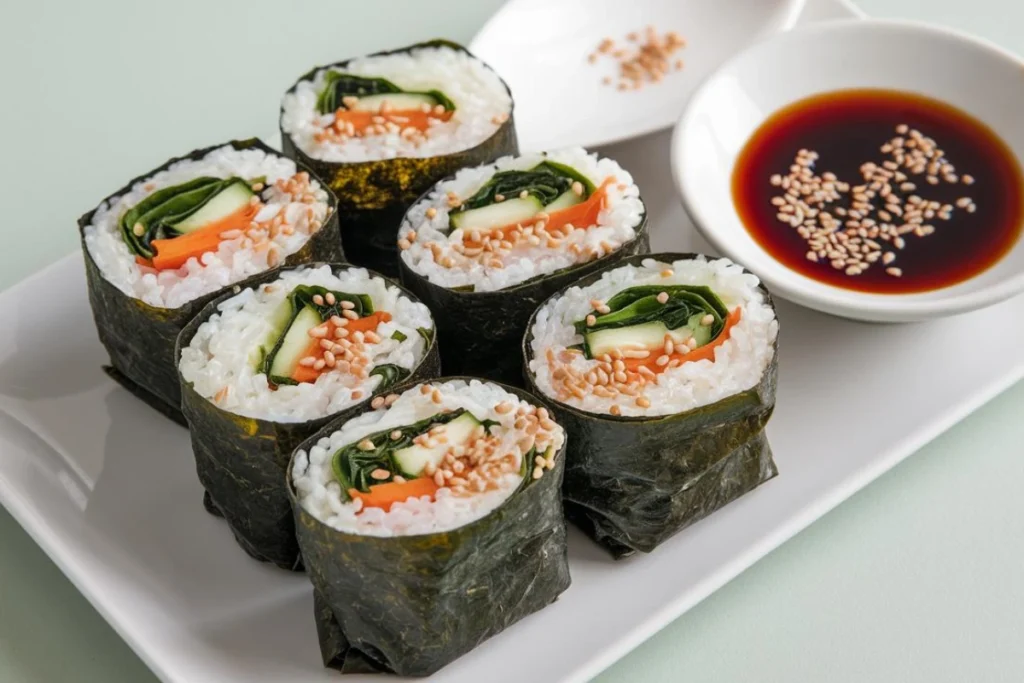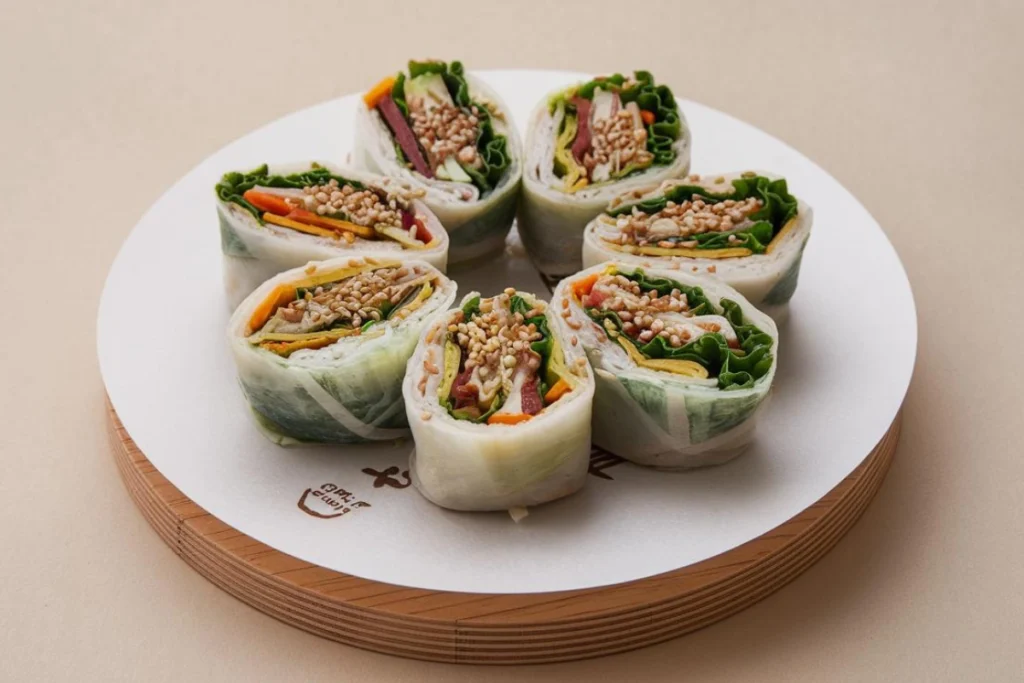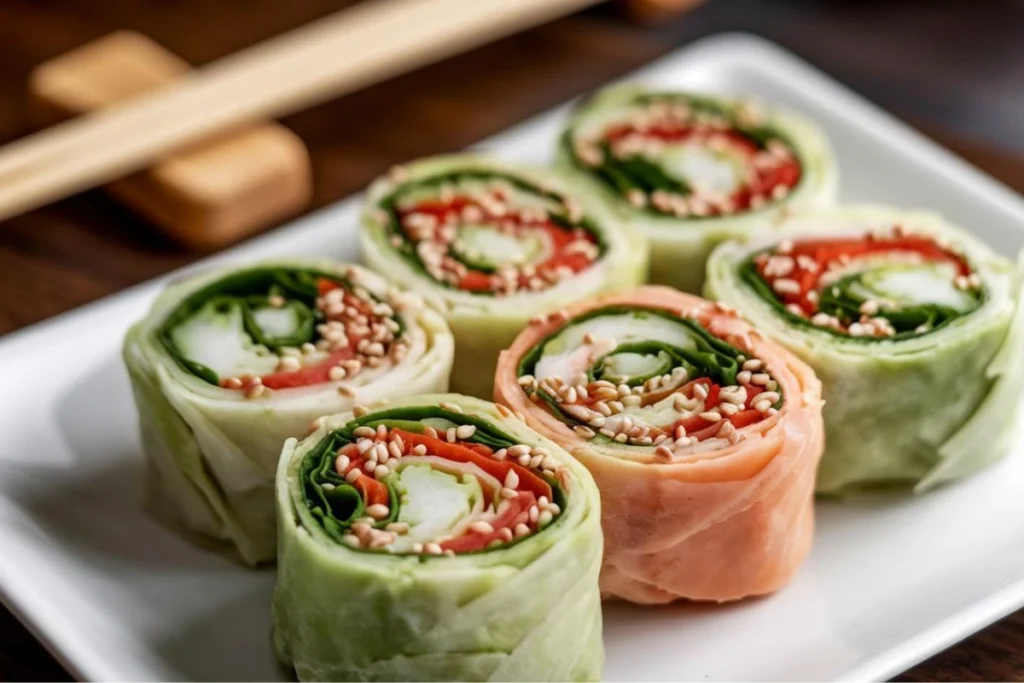Gimbap, often referred to as Korean sushi, is a popular dish that has gained international acclaim for its convenience, taste, and balance of ingredients. But for those who are health-conscious or tracking their calorie intake, an important question arises: how many calories are in gimbap? In this comprehensive guide, we’ll break down the caloric content of gimbap, explore its nutritional value, and offer tips for enjoying this delicious dish while maintaining a balanced diet.
Introduction to Gimbap and Its Popularity
Gimbap is a traditional Korean dish made from cooked rice and various other ingredients, all rolled in a sheet of seaweed (kim). It is a versatile dish, often enjoyed as a quick snack, a light meal, or even as part of a larger Korean feast. Gimbap’s popularity stems from its adaptability—ingredients can range from simple vegetables to more complex combinations involving proteins like eggs, beef, or fish.
As the world becomes more health-conscious, understanding the caloric content of the foods we consume is essential. Gimbap, with its seemingly innocent appearance, might surprise you with its calorie count. For a detailed understanding of how gimbap fits into a healthy diet, you can explore Healthy Korean Food Choices.
Caloric Content of Gimbap: An Overview
The calories in gimbap can vary significantly depending on the ingredients used and the size of the roll. However, there are general estimates that can help you gauge how many calories you might be consuming with each bite.
Average Caloric Content Per Roll
On average, a single roll of gimbap contains approximately 300 to 500 calories. This range depends on several factors, including the type of rice used, the fillings, and the size of the roll. Gimbap made with more vegetables and lean proteins will typically be lower in calories, while those with higher fat content, such as those including mayonnaise or processed meats, will be on the higher end of the spectrum.
Comparison with Similar Dishes
Compared to similar dishes, such as sushi rolls, gimbap can be slightly higher in calories, primarily due to the use of sesame oil and the variety of fillings. While sushi often includes raw fish and less rice, gimbap is typically packed with a broader range of ingredients, contributing to its higher calorie count.
For a more detailed comparison between gimbap and other healthy options, consider exploring the Nutritional Benefits of Brown Rice, which is often used in gimbap as a healthier alternative to white rice.

Breaking Down the Calories in Gimbap
To fully understand the caloric content of gimbap, it’s essential to break down the calories by each major ingredient. This section will explore the primary components that contribute to the overall calorie count.
Rice
The rice in gimbap is one of the most significant contributors to its caloric content. Whether you opt for white rice or brown rice can make a noticeable difference in the number of calories.
- White Rice: A staple in traditional gimbap, white rice is often seasoned with sesame oil and salt, adding flavor but also calories. A single roll of gimbap made with white rice typically contains around 150-200 calories from the rice alone.
- Brown Rice: While less traditional, brown rice is a popular alternative for those seeking a healthier option. It is higher in fiber and nutrients but slightly lower in calories, contributing approximately 120-150 calories per roll.
Vegetables
Vegetables are an essential part of gimbap, providing not only flavor and texture but also vital nutrients. The good news is that most vegetables used in gimbap are low in calories.
- Carrots: A common ingredient, carrots add about 10-15 calories per roll.
- Spinach: Often used in gimbap, spinach is low in calories, adding roughly 5-10 calories per roll.
- Cucumbers: Another popular choice, cucumbers contribute approximately 5-8 calories per roll.
Proteins
The choice of protein in gimbap can significantly impact its calorie count. Common proteins include eggs, fish, and meat.
- Eggs: A traditional ingredient in gimbap, eggs can add about 70-90 calories per roll.
- Fish: Depending on the type, fish such as tuna or salmon can add anywhere from 50-100 calories per roll.
- Meat (Beef or Chicken): If your gimbap includes meat, expect an additional 100-150 calories per roll, depending on the portion size and preparation method.
Additional Ingredients
Gimbap often includes additional ingredients like pickled radish, sesame seeds, and sometimes cheese, all of which contribute to the overall calorie count.
- Pickled Radish (Danmuji): A traditional component, pickled radish adds about 5-10 calories per roll.
- Sesame Oil and Seeds: These are used both in the rice and as a garnish, adding 20-30 calories per roll.
- Cheese: Some modern variations of gimbap include cheese, which can add an extra 50-80 calories per roll.
Variations of Gimbap and Their Caloric Differences
The beauty of gimbap lies in its versatility. There are countless variations, each with its own unique caloric content. Here, we’ll explore some popular variations and how they differ in terms of calories.
Classic Gimbap
The classic gimbap, made with white rice, various vegetables, and eggs or meat, generally contains around 350-450 calories per roll. This version strikes a balance between flavor and nutrition, making it a popular choice.
Vegetarian Gimbap
For those seeking a lighter option, vegetarian gimbap is a great choice. By omitting meat and focusing on vegetables and possibly tofu, the caloric content drops to about 250-350 calories per roll, depending on the specific ingredients.
Low-Calorie Gimbap
To create a low-calorie gimbap, consider using brown rice or cauliflower rice and filling the roll with primarily vegetables and lean proteins. This variation can reduce the calorie count to as low as 200-300 calories per roll.
High-Protein Gimbap
If you’re looking to increase your protein intake, a high-protein gimbap might include additional ingredients like beef, chicken, or extra eggs. This version can contain 400-500 calories per roll, depending on the portion sizes and types of protein used.
Fusion Gimbap
Fusion gimbap incorporates non-traditional ingredients, such as avocado, cream cheese, or even spicy mayonnaise. These additions can increase the calorie count to 450-550 calories per roll, making it a more indulgent option.

Health Considerations Beyond Calories
While understanding the caloric content of gimbap is important, it’s equally crucial to consider its overall nutritional value. Gimbap is not just about calories—it’s a nutrient-rich food that can contribute to a balanced diet.
Nutritional Value of Gimbap
Gimbap provides a well-rounded mix of macronutrients, including carbohydrates, proteins, and fats. The vegetables offer a range of vitamins and minerals, such as vitamin A, vitamin C, calcium, and iron. Additionally, the presence of dietary fiber from vegetables and brown rice supports digestive health.
- Macronutrients: On average, a roll of gimbap provides about 30-50 grams of carbohydrates, 10-15 grams of protein, and 5-10 grams of fat.
- Micronutrients: The vegetables in gimbap are rich in antioxidants, which help protect against oxidative stress and inflammation.
Gimbap and Weight Management
Given its balanced nutritional profile, gimbap can be an excellent choice for those looking to maintain or lose weight. The key is to focus on portion control and choose ingredients that align with your dietary goals. For example, opting for lean proteins and vegetables while minimizing high-calorie condiments can help you enjoy gimbap without exceeding your calorie budget.
Potential Drawbacks
Despite its many benefits, there are some potential drawbacks to consider, particularly for those monitoring their sodium intake or blood sugar levels.
- Sodium Content: Gimbap often includes pickled vegetables and soy sauce, which can contribute to higher sodium levels. If you’re concerned about sodium, consider using low-sodium alternatives or reducing the amount of pickled ingredients.
- Glycemic Index: The use of white rice in gimbap can lead to a higher glycemic index, which may impact blood sugar levels. Opting for brown rice can help mitigate this effect.
Tips for Reducing Calories in Gimbap
If you’re looking to enjoy gimbap while keeping the calorie count low, here are some practical tips.
Ingredient Substitutions
One of the easiest ways to reduce the calorie content of gimbap is by making smart ingredient substitutions.
- Rice Alternatives: Replace white rice with brown rice or even cauliflower rice to lower the calories and increase fiber.
- Lean Proteins: Opt for lean proteins like chicken breast, tofu, or fish instead of higher-fat meats.
- Reduce Sesame Oil: While sesame oil adds flavor, it also adds calories. Consider reducing the amount or using a spray to control the portion.
Portion Control
Another effective strategy is to focus on portion control. Instead of consuming an entire roll of gimbap, consider enjoying half a roll with a side of salad or soup. This can help you feel satisfied without overindulging.
Homemade vs. Store-Bought
Making gimbap at home gives you complete control over the ingredients and portion sizes. This can be especially beneficial if you’re trying to reduce the calorie content or make the dish healthier overall.
- Homemade Gimbap: Allows you to customize the ingredients to fit your dietary needs, ensuring a healthier, lower-calorie meal.

FAQs About Gimbap
How many calories are in a roll of gimbap?
The number of calories in a roll of gimbap typically ranges from 300 to 500 calories, depending on the ingredients and portion size. The type of rice, proteins, and additional ingredients like sesame oil or cheese can all affect the final calorie count.
Is gimbap healthy for weight loss?
Yes, gimbap can be a healthy option for weight loss, especially when made with lower-calorie ingredients such as brown rice, lean proteins, and a variety of vegetables. Portion control and mindful ingredient choices are key to making gimbap a weight-loss-friendly food.
Can I make low-calorie gimbap?
Absolutely! To make low-calorie gimbap, substitute white rice with brown rice or cauliflower rice, focus on filling the roll with vegetables and lean proteins, and reduce or omit high-calorie ingredients like sesame oil or processed meats.
What is the best way to reduce the sodium content in gimbap?
To reduce the sodium content in gimbap, consider using low-sodium soy sauce, reducing the amount of pickled vegetables, and avoiding additional salty condiments. Fresh vegetables and lean proteins can help keep the sodium levels in check while still providing flavor.
Conclusion
Gimbap is a delicious and versatile dish that can fit into a variety of diets and lifestyles. While it does contain a range of calories depending on the ingredients used, it is also packed with essential nutrients that make it a valuable part of a balanced diet. By understanding the caloric content and making smart ingredient choices, you can enjoy gimbap as a healthy, satisfying meal that supports your nutritional goals.
Whether you’re looking to lose weight, maintain a healthy diet, or simply enjoy a flavorful dish, gimbap offers a unique combination of taste and nutrition that’s hard to beat. So next time you’re in the mood for a quick and convenient meal, consider making or choosing gimbap, and enjoy all the benefits it has to offer.

